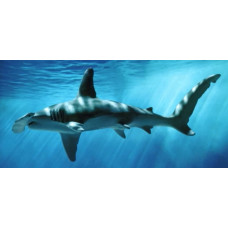Latin name
Sphyrna mokarran
Other names
Sphyrna mokarran
Identification
They have a characteristic spindle-shaped body and head with projections on the sides. In adults, the front of the head is practically straight, with projections in the middle and on the sides. The width of the wings is 23-27% of the body length. The skin is covered with densely packed placoid scales. Each scale is lozenge-shaped and bears 3-5 horizontal ridges ending in teeth.
Teeth
Teeth are triangular with sharply serrated edges, sloping more and more towards the corners of the mouth. There are 17 teeth on each side of the upper jaw, 2-3 on the symphysis, and 16-17 on each side of the lower jaw, 1-3 on the symphysis.
Features of fish fins
The first dorsal fin is very high, sickle-shaped, with the base above the caudal projection of the pectoral fins. The second dorsal fin and anal fin are relatively large, with deep notches along the caudal margin. The pelvic fins are sickle-shaped with concave caudal margins.
Fish colouring
The colouration is dark brown to light grey and olive with a pale belly. Adult fins are unsigned, although the tip of the second dorsal fin may be dark in immature sharks.
Distribution
Widespread in tropical and warm temperate waters between 40°N and 37°S. In the Atlantic it is found from the coast of North Carolina to Uruguay, including the Gulf of Mexico and the Caribbean, and from Morocco to Senegal, as well as in the Mediterranean. Widespread in the Indian and Pacific Oceans from the Ryukyu Islands to Australia, New Caledonia and French Polynesia, and from southern California to Peru. Occurs off the coasts of Gambia, Guinea, Mauritania, Sierra Leone, Western Sahara.
Habitat
A marine, brackish, pelagic-oceanic, oceanodromous, subtropical species. Great hammerheads can be found in shallow waters as well as at depths of up to 80 metres. It prefers to live near coral reefs, on the continental shelf and in lagoons.
Size
The average length is 3.5 m and the mass is over 230 kg. Females tend to be larger than males. There is evidence that a hammerhead shark measuring 7 metres 89 centimetres long and weighing 363 kilograms has been caught off the coast of New Zealand. However, even these sizes are not the maximum, for example a giant shark weighing 453.6 kilograms was caught in Florida (USA) in the summer of 2010. The female, caught off the coast of Florida in 2006, weighed 580 kg and was 5.5 metres long. Such a large mass is explained by the fact that the female was pregnant with 55 embryos.
Behavior
Migrates seasonally.
A solitary, nomadic predator that generally avoids other sharks. Immature individuals are sometimes preyed upon by large sharks. Sometimes accompanied by Naucrates Doctor.
Food and feeding habits
It is an active predator. Its diet is varied and includes invertebrates such as crabs, lobsters, squid, octopus, and bony fish such as tarpon, sardines, catfish, oysterfish, Sparidae, Pomadasys, Trachurus, Sciaenidae, Sebastes, flatfish, Ostraciidae, Diodon and small sharks such as Mustelus. In Rangiroa Atoll they prey on Carcharhinus amblyrhynchos. They have been known to eat individuals of their own species.
They usually hunt at dawn or dusk. They drive their head over the seabed to detect rays buried in the sand with the help of the numerous ampullae of Lorenzini located on the underside of the "hammer". The distinctive head also allows the sharks to quickly turn and strike the stingray when it is spotted. The spotted eagle ray is a common prey of the great hammerhead.
Reproduction
Like other members of their genus, they are viviparous; developing embryos are nourished by a placental connection to the mother formed by an empty yolk sac. Unlike most other sharks, which mate closer to the bottom, these sharks mate near the surface. In one observation in the Bahamas, two sharks were seen swimming in circles, rising from the depths and beginning to mate when they reached the surface. Females can reproduce by parthenogenesis, i.e. without mating with a male. In parthenogenesis, DNA is only passed from the mother to the offspring. Females give birth every two years. In the northern hemisphere, births occur in late spring and summer, and in Australian waters in December and January. Pregnancy lasts 11 months. There are 6-55 newborns in a litter, with an average of 20-40, and they are 50-70 cm long. Males and females reach sexual maturity at 2.3-2.7 m and 51 kg and 2.5-3.0 m and 41 kg respectively. Juvenile sharks differ in appearance from adults, with a rounded forehead. The average lifespan is 20-30 years and the maximum is 40-50 years.
Fishing
A regular target of commercial and recreational fisheries in the tropics, they are caught using longlines, bottom-set gillnets, trawls and hook-and-line nets.
Relationship with a person
Aggressive behaviour towards humans is expressed by sharks lowering their pectoral fins and making sharp, gusty movements. However, they are usually shy or show no interest in humans.
Their meat is rarely eaten, but their fins are highly prized as an ingredient in soup. Their liver and skin are used, and the carcass is used to make fishmeal.
| Classification | |
| Phylum | Chordata |
| Class | Chondrichthyes |
| Squad | Carcharhiniformes |
| Family | Sphyrnidae |
| Genus | Sphyrna |
| Species | S. mokarran |
| Features | |
| Conservation status | Critically Endangered |
| Habitat | Pelagic |
| Life span, years | 50 |
| Maximum body weight, kg | 453,6 |
| Maximum length, cm | 789 |
| Sailing speed, m/s | No information |
| Threat to people | Edible |
| Way of eating | Predator |
Great hammerhead
Tags: great hammerhead



